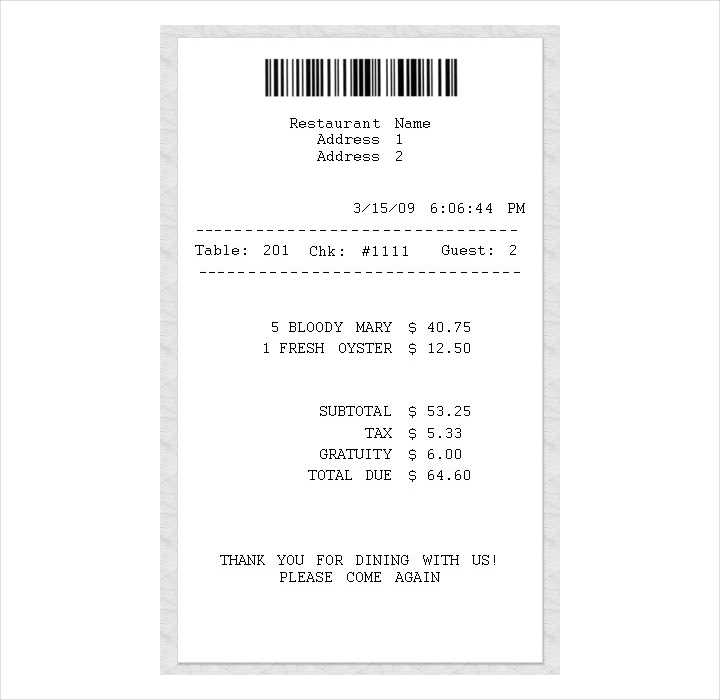
Need a simple and professional restaurant receipt? Download a free printable template that fits your business needs. Whether you run a small café or a full-service restaurant, a well-structured receipt helps track sales, provide proof of purchase, and enhance customer experience.
A clear receipt should include the restaurant name, address, contact details, itemized charges, taxes, and payment method. Customizing a template ensures it reflects your branding while maintaining accuracy. Adding a logo and adjusting the layout can create a polished look that customers appreciate.
Choose a template that supports various formats like PDF or Excel for easy editing and printing. Some templates come with built-in formulas, automatically calculating totals and taxes, saving time for your staff. For a seamless process, ensure the design matches your POS system for smooth integration.
Print high-quality receipts on standard paper or thermal rolls, depending on your setup. If you need digital copies, consider using fillable PDF forms or integrating with accounting software for organized record-keeping. A well-structured receipt not only looks professional but also improves business efficiency.
Free Printable Restaurant Receipt Template
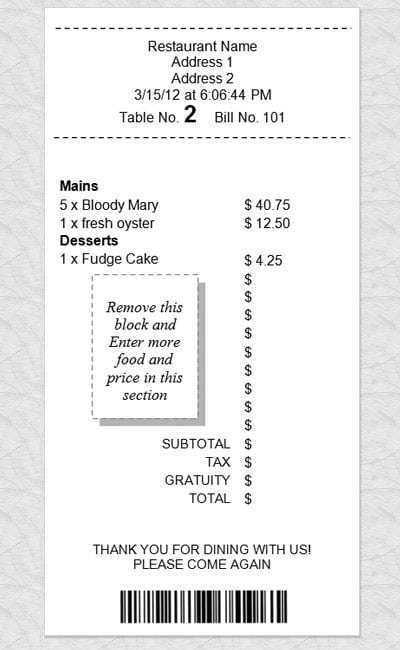
Choose a template with a clear layout that includes itemized charges, taxes, and payment details. A well-structured receipt ensures transparency and minimizes disputes. Opt for a design that aligns with your restaurant’s branding by customizing fonts, logos, and colors.
Key Elements to Include
Ensure the receipt features essential details: restaurant name, address, date, order breakdown, subtotal, taxes, total amount, and payment method. Adding a section for tips and customer notes can enhance the experience. If your restaurant offers loyalty programs, consider including a QR code or a discount code for future visits.
Printing and Digital Options
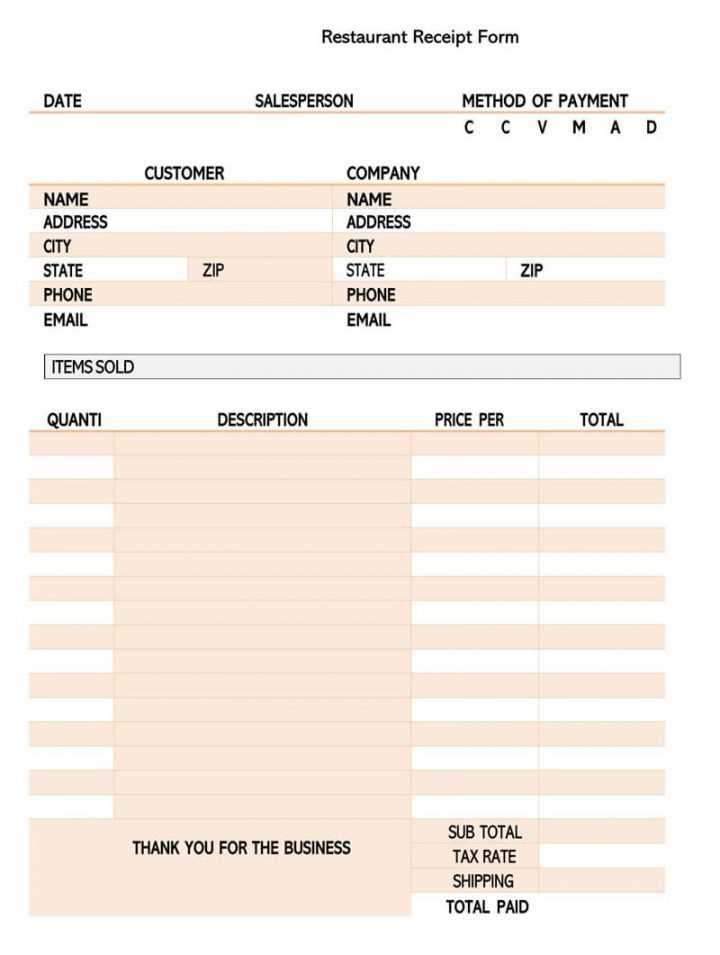
Print templates on thermal paper for quick transactions, or use a standard format for emailed receipts. A digital version with interactive fields allows customers to save a copy easily. Providing both options improves convenience and caters to different preferences.
Key Elements of a Restaurant Receipt Template
Ensure the receipt includes the restaurant’s name, address, and contact details at the top. This makes it easy for customers to reach out if they have questions about their order.
Clearly list each purchased item with its price. Use a structured format that includes item descriptions, quantity, and individual costs to prevent confusion.
Display the subtotal before applying taxes or discounts. This helps customers understand the breakdown of charges.
Indicate any applicable taxes separately. Label them correctly based on local regulations to maintain transparency.
Highlight discounts or promotions, showing the original price and the deducted amount. This reassures customers that the offer has been applied correctly.
Show the final total prominently. Use bold or larger font sizes to make it stand out.
Include the payment method and transaction details. If the receipt is for a card payment, list the last four digits of the card and the approval code.
Add a timestamp with the date and time of the transaction. This serves as a reference for both customers and restaurant staff.
Provide a space for a signature if needed, especially for large orders or tips on card payments.
Optionally, add a short message thanking the customer or inviting them to return. A simple note can enhance customer experience and encourage repeat visits.
How to Customize a Printable Receipt for Your Business
Use a clear and readable font. Customers need to quickly verify charges, so choose a professional typeface like Arial, Helvetica, or Times New Roman. Avoid decorative fonts that reduce readability.
Include your business name and logo at the top. A high-quality logo adds credibility and reinforces branding. Use a PNG or SVG file to maintain sharpness when printing.
Adjust the layout to fit your receipt printer. Standard paper sizes vary, so check whether you need a 58mm, 80mm, or letter-sized format. If printing on thermal paper, ensure margins align with your printer’s specifications.
Customize the itemized section. Clearly list purchased items, quantities, prices, and applicable taxes. Use columns for easy scanning and align figures to the right for clarity.
Add personalized messages. A short thank-you note or a discount code for the next visit encourages repeat business. Place this near the bottom to ensure visibility without distracting from essential details.
Ensure compliance with local regulations. Some regions require specific details, such as tax identification numbers or refund policies. Check legal requirements before finalizing your design.
Save the template in a widely compatible format like PDF or DOCX. This ensures easy printing across different devices without formatting issues.
Best Formats for Printing and Digital Use
PDF ensures consistent formatting across all devices and printers. It locks in fonts, spacing, and layout, preventing unwanted adjustments. Most businesses prefer PDF for invoices and receipts due to its compatibility with standard printing software.
Optimized Formats for Printing
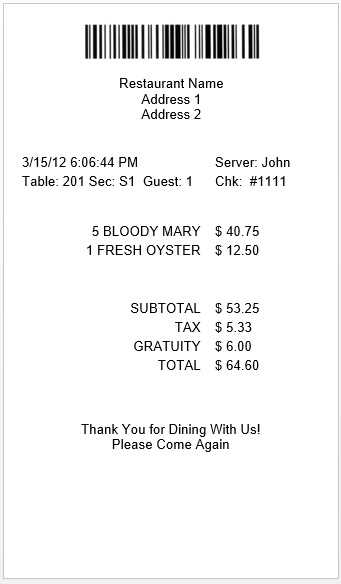
- PDF: Preserves formatting, prevents accidental edits, and works with all printers.
- TIFF: High-quality image format suitable for detailed receipts but results in larger file sizes.
- PNG: Supports transparency and sharp text but lacks multiple pages.
Best Formats for Digital Use
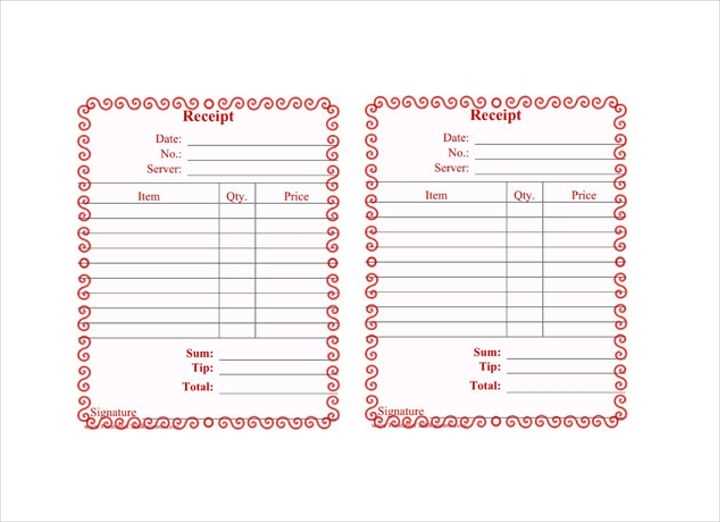
- PDF: Easy to share, view on any device, and secure with password protection.
- JPEG: Compressed file suitable for email attachments, though it may lose quality.
- HTML: Ideal for web-based receipts, allowing dynamic content and easy online storage.
For maximum versatility, create receipts in both PDF and HTML formats. This ensures professional printing while maintaining flexibility for digital use.


